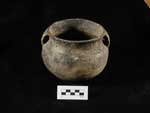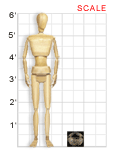From the collection of:
William S. Webb Museum of Anthropology || VAM Home
Mississippian Culture
CERAMIC JAR, Caborn-Welborn Phase, Late Prehistoric Period, 1450-1700 CE
Slack Farm Site, Union County, Kentucky
Earthenware, clay mixed with crushed shell; 13 cm. height X 15.1 cm. diameter
Catalog Number 15UN28-181-1
William S. Webb Museum of Anthropology, University of Kentucky
The prehistoric Caborn-Welborn people, who farmed the fertile floodplains near the mouth of the Wabash River more than 400 years ago, lived in farmsteads, hamlets, and villages. They made ceramic vessels from local clay mixed with crushed freshwater mussel shell in a variety of sizes and shapes—jars, bowls, bottles, shallow pans, and even tiny miniature pots. Exterior decoration on these vessels consisted of geometric designs made by incising, painting, or negative resist painting; a red slip that covering the whole vessel; or added clay fashioned into human or animal figures. These vessels were used for daily activities like storing food or water and for cooking, as well as for ritual, ceremonial, and burial purposes.
This plain-surfaced jar is a common type of Caborn-Welborn vessel. However, the scrolled, single-punctation design incised at the base of the vessel neck is quite rare. The jar also is punctated along the exterior of the lip. Given the size of this particular vessel, it is likely that it served a mortuary function.
Classroom Ideas
Discussion: It is believed that this vessel was used for funerary purposes. Is there anything you notice about the jar that supports this idea? What might the purpose of the handles have been? Would you have guessed that this object was made about 500 years ago? Why or why not?
Activity: Compare this jar to Sarah Frederick’s Gold Calabash Bowl in the Kentucky Museum of Art and Craft gallery. Compare and contrast the appearances, construction methods, and purposes of the two ceramic vessels. Research the evolution of ceramics in the last 500 years. How have ceramic-making processes changed since the Caborn-Wellborn people? Have any methods remained the same? Do you think it is important for potters to learn about the ceramic methods of earlier cultures? Why or why not?
Links
Learn more about Kentucky archaeological sites and discoveries at the Kentucky Archaeological Survey web site.
[www.kyheritage.org/kas.htm]
Use these resources from the National Park Service’s Southeast Archaeological Center to explore the prehistory of the region:
- Mississippian and Late Prehistoric Period (900 -1700 CE)
[www.cr.nps.gov/seac/misslate.htm] - Southeastern Prehistory: Mississippian and Late Prehistoric
[www.cr.nps.gov/seac/outline/05-mississippian] - Ancient Architects of the Mississippi
[www.cr.nps.gov/aad/feature/feature.htm]
You’ll find a Mississippian Period bowl and bottle on the Metropolitan Museum of Art’s Timeline of Art History.
[metmuseum.org/toah/ht/07/na/ht07na.htm]
See the William S. Webb Museum of Anthropology site for lots of teaching resources, including information about time periods, online activities, and lesson plans.
[www.uky.edu/AS/Anthropology/Museum/museum.htm]

